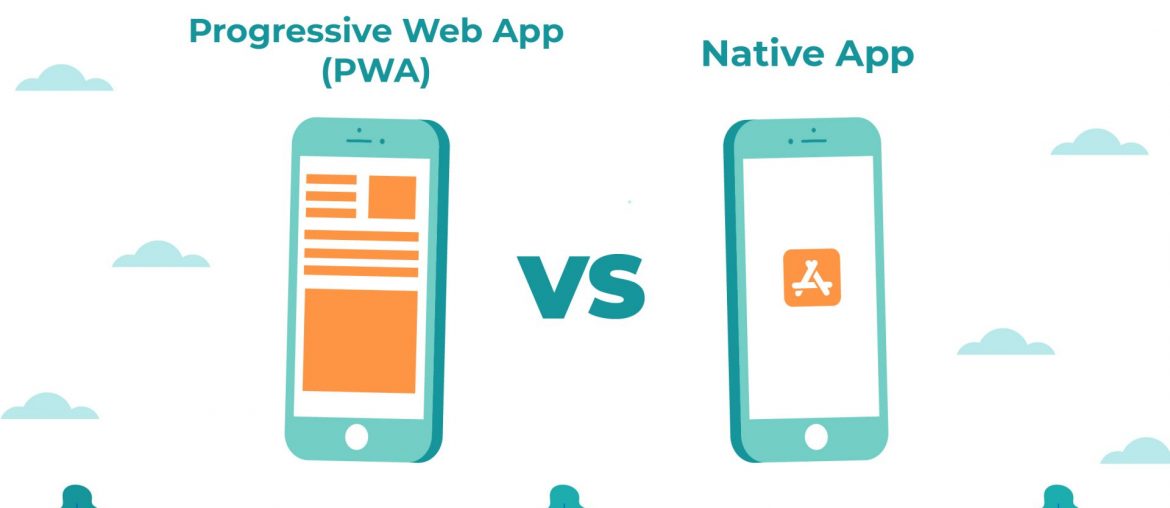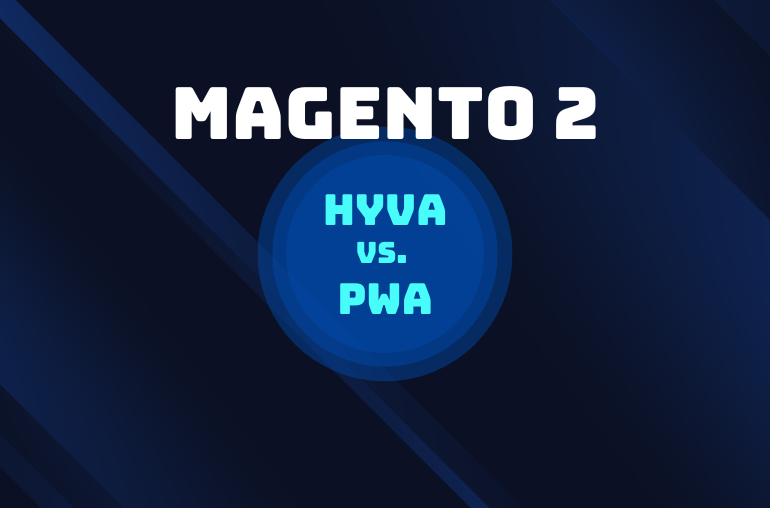Table of contents
You probably already have a general idea of what a native app is—since app stores are all but packed with it—but to most of us, PWA is still a relatively unknown technology with unclear definitions. And that’s what we’re here to find out.
What is a native app?
A native app is an app that is native to the operating system or the platform that it is on. Essentially, this means that the app was specifically built with one OS/platform in mind for the best compatibility and performance results.
What is a PWA?
Short for Progressive Web App, PWA is a recent emergence in all the popular marketplaces owing to its ability to seamlessly function on any device with a compatible browser.
Make no mistake: a Progressive Web App is still a website. It just looks and feels like an app, thanks to modern web technology. Users will browse Progressive Web App on their browser with an URL just like they do any website, but right after they land on the PWA, they get the experience of using an “app”, right on their browser, without the need to download and install. How cool is that!
Furthermore, PWA sites can be indexed by Googlebot so you can optimize them based on Google’s guidelines and best practices for higher rankings. This isn’t the case with a mobile app. Moreover, web apps can be linked to and shared, and distributed via web, so this increases the chance of being discovered via other platforms and social media.
Recommended reading:
All you need to know about Progressive Web Apps
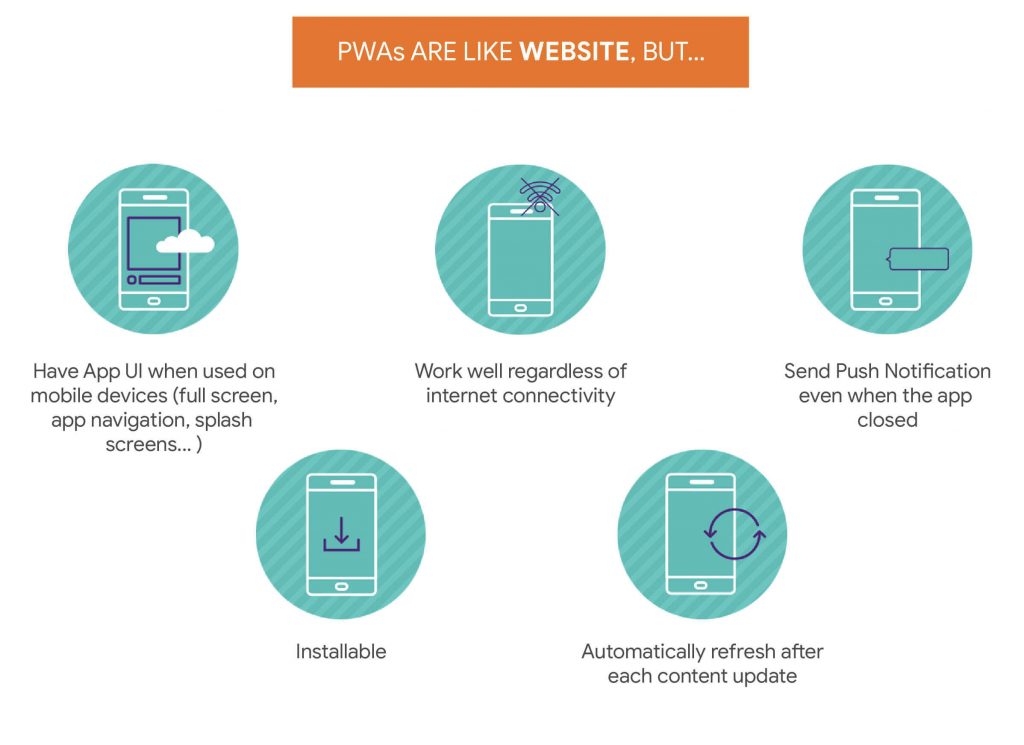
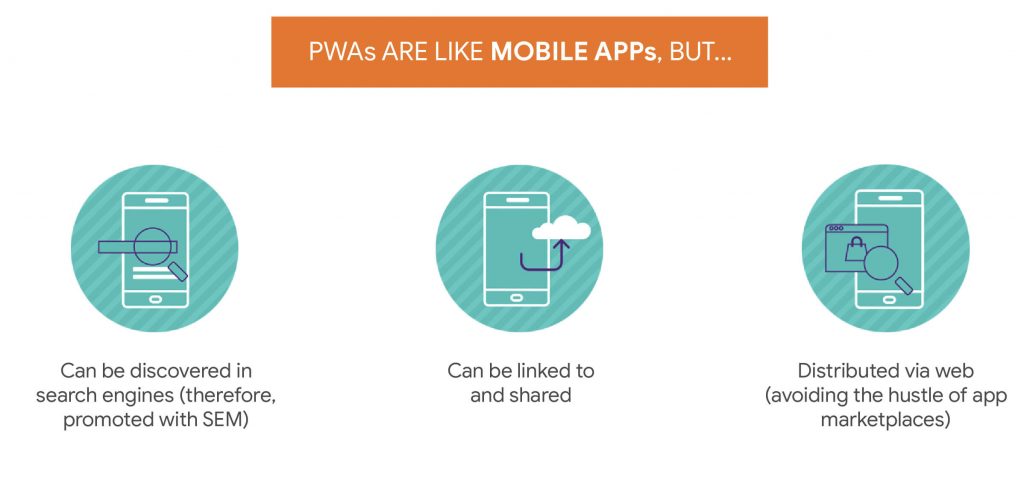
Pros and Cons
Let’s first look at the advantages and drawbacks of PWA and native app.
Native Apps
Pros:
- Performance: As the app has been developed using the device’s native language, it offers high speed and optimized performance. Memory utilization and power consumption is also considered during development.
- Look and feel: native apps offer the best UI/UX experience with appealing layouts, animations and effects, smooth scrolling and effective gesture control and more.
- Personalization: Native apps allow you to collect data to personalize the customer experience. For example, an app can ask users some basic questions (e.g name) then addressing them by their name during the onboarding process, in-app and push notifications. Another practice is that the app can make recommendations based on previous purchases. This makes the user feels more connected to the app/brand.
- Data protection and security: these apps make use of the device’s functionality and resources efficiently. Data security is well maintained.
- Hardware accessibility: native apps offer easy interaction with hardware aspects. They provide faster access to built-in device features like GPS, Contact, Camera and Media.
Cons:
- Learning cost: you’ll need to learn different languages to develop a native app on separate platforms: Java & Kotlin for Android, Swift or Objective-C for iOS, C# for Windows phones. Sound like a lot right?
- Long installation: users need to look for the app on a specific app store, download and wait for it to be installed on their device. Depends on the internet connection, the download may be agonizingly long.
- Development cost and time: if you want to publish your app on iOS and Android, meaning you’ll need two versions of the app, plus the resources to maintain and update them. This obviously demands a great deal of time and budget.
PWA
Pros:
- Platform-independent: since PWAs are accessed from web browser, you don’t have to submit your app to the app store. PWAs can run on any type of device – iOS or Android or others.
- App-like performance: customers are usually annoyed when accessing sites from their mobiles due to unreliable and slow performance. But PWAs can deliver a fast and smooth experience similar to any native app.
- Lower development costs: PWA only needs to be developed once to fit on different devices, so it’d save businesses a considerable amount of money and time.
- No download or installation: this is one of the most prominent benefits of PWA. Users only need to pin it on their home screen, and they can access it quickly with just a tap on the icon.
- Offline mode: thanks to Service Worker, PWAs can function well without an Internet connection. After a user’s first visit to a PWA site, the person can come back and interact with it smoothly even without an internet connection.
- Memory-friendly: PWAs only use a small chunk of data on devices. Since users don’t have to install PWAs, it saves them a lot of memory storage.
- Engaging: With PWAs, you can send push notifications with useful information to users to engage them. PWA’s UX/UI also makes it feel like they are using a native app.
- Sharability: you can share the PWA’s unique URL to others via platforms or social media.
- Up-to-date data: The Service Worker update process keeps a PWA site’s content updated automatically and continuously.
Cons:
- Limited hardware access: PWAs have few limited access to the hardware and software features.
- Lack of support: because PWA is still an emerging technology, not all browsers support this type of software.
Detailed Comparison
There’s a lot to unpack here, so let’s focus on the most important parameters:
Development cost
In this aspect, it’s obvious that PWA is the winner. It’s not only cheaper to build a PWA, but it also takes less time to develop and update. Since PWA sites are responsive, they can work reliably across multiple devices and platforms.
For a native app, a company would need to work on the development project twice – one for iOS and one for Android, if they desire to have their app published on both platforms. Although a native app may let you configure more advanced features, it also means more time and money needed to invest.
Performance
Performance-wise, these two are pretty similar. On the same modern smartphone device, PWA has the advantage of being quick to launch, lightweight, and the whole experience has been described to be like that of a lite version of the native application.
The Weather Channel saw a 80% improvement in load time with Progressive Web App
Google Case Studies
However, we’ve seen reports from our customers saying that PWA—while taking up less storage space and easier on the battery consumption—tends to leave them with a feeling of clunkiness and just overall not as smooth as native applications. From our experience as an expert Magento PWA solution, we can see that this is the result of PWAs being coded using outdated methods of animation handling.
Native apps, since are built to optimize the resources of specific platforms, can access device hardware to deliver a better experience. Also, native apps are less battery-consuming if compared to PWA.
Features
With better access to system hardware, you can expect native apps to be more features-packed and more integrated within the system. This potentially leads to more stability, security, and more features that require cross-app communication.
Native apps can have some advanced functionalities like geofencing, interacting with other apps, and accessing phone device features (proximity sensor, ambient light detection).
Of course, PWA is still more than sufficient for most use cases as PWA, in ideal conditions, rivals even native apps in the number of features offered. Useful features such as media capture, push notifications, authentication, speech synthesis, … are sufficient to cater to the majority of users.
Security
This is where PWA loses, but not by a large margin. Native apps are naturally better at security since they have better access to hardware components, thus being able to implement additional layers of security—e.g. Two-Factor Authentication. And because an app needs to pass the app store’s security requirements to get published, users are more likely to trust an app.
PWA has a different approach to security since Google requires that all communications between the server and the client are to be encrypted through the use of HTTPS. There’s little to no reason to not go for HTTPS.

Related article:
Discoverability
The native app might not be the best way to reach users. You have to lead users from discovering your app on the app store to downloading it, which isn’t an easy task. This is the reason why the average user downloads zero apps a month.
PWA has a slight edge over mobile app when it comes to discoverability. It can be available on both the web and app marketplaces, which makes it the current way to go forward in the software delivery department. And PWAs can be pinned on the home screen instantly with a tap.
The streaming platform ZEE5 launched a PWA to expand its reach. The PWA is three times faster and reduced the buffering time by 50%.
PWAStats
PWA sites can be discovered by search engines like Googlebot, unlike native apps. PWAs are still indexable and this may help to gain organic traffic and boost the rankings on SERPs.
Examples of the two technologies
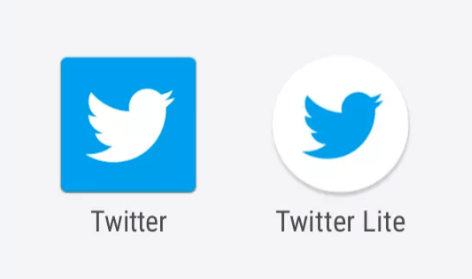
- Twitter Lite: Before Twitter released its PWA, the social media network struggled to create a desirable user experience for its mobile users, who were complaining about long loading times and poor responsiveness. Twitter Lite completely changed Twitter’s reputation when it comes to mobile, and the PWA now generates more than ten million push notifications per day.
- Forbes: It is a well-known statistic that 53% of mobile site visitors will leave a page that takes longer than three seconds to load. But Forbes’s previous mobile website’s loading time can reach as much as 6.5 seconds. After releasing a PWA, the load time decreased and the media company almost immediately experienced a 12% increase in readership.
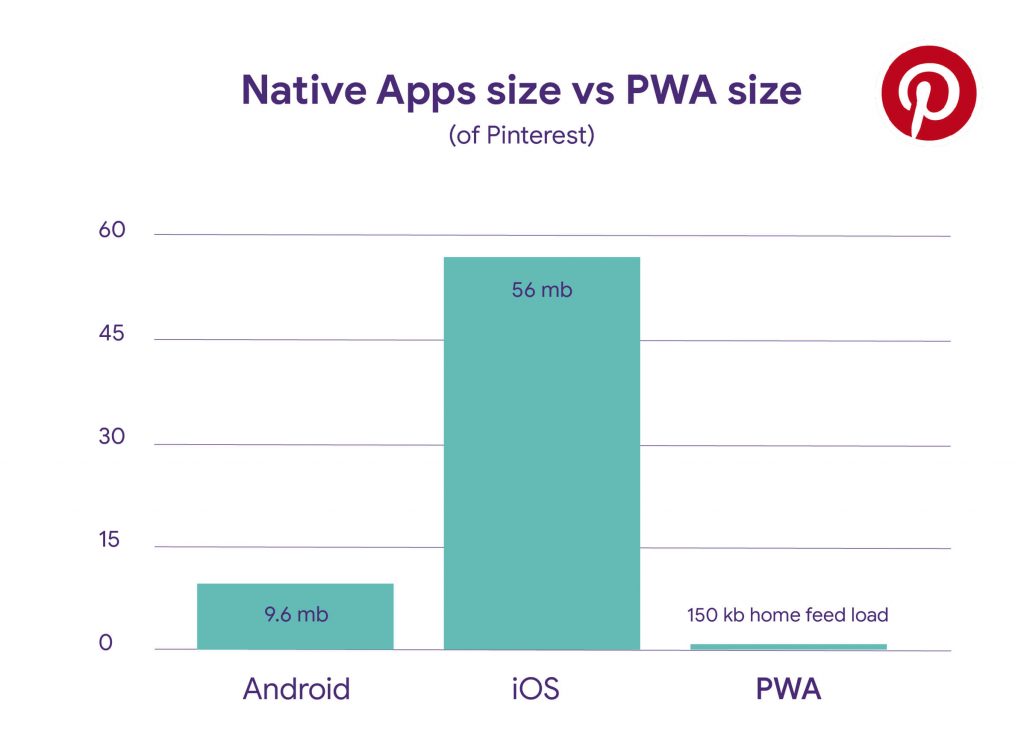
- Pinterest: With a focus on international growth, Pinterest started their new mobile web experience from the ground up as a PWA. The social network found that only 1% of their mobile users convert into sign-ups, logins, or app installs, due to poor performance on mobile. Realizing that the opportunity to improve the conversion was huge, so they rebuilt the mobile web using PWA technology, which led to positive results: Time spent is up by 40% compared to the previous mobile web, user-generated ad revenue is up 44% and core engagements are up 60%.
Read more:
12 Best Examples of Progressive Web Apps
So, when does it make sense to go with…
Progressive Web App
Platform availability
With only one single codebase needed for all supported platforms, PWA is your best bet at expanding the reach of your business. Currently, PWA is supported on almost every available platform.
Recommended reading:
Publishing PWAs to Major App Stores
Low development cost
PWA saves you the development cost for multiple platforms, as with PWA you should only need one functional codebase for all supported operating systems and browsers.
Boost brand awareness
PWAs take up much less data storage on devices, so this works as a reason for users to add it to their home screen. And SMEs can use this to their advantage to put their brand on a customer’s device screen.
In most cases, users would pin the PWA only after they’re sure the site has everything they need. So businesses can expect a higher engagement rate for PWAs. More importantly, statistics show that user sessions on PWAs are 78,25% longer than websites and apps!
Seamless operation
Everything, including app updates, happens on the fly with PWA. This is all to ensure that the user will have the best experience without any hiccup along the way. PWA installations are done within seconds, and every update happens in the background, with service workers playing the main role in caching content from the server.
Native Apps
Looking at all the success of PWAs, you might be wondering if there’s even a point to native apps anymore. Well, obviously there are many, as native apps are a tried and proven method for software delivery. Here are the benefits that native apps have over PWAs:
Performance and features
Performance and features are the number one reason why brands don’t mind spending more to get a native app for popular mobile operating systems (iOS and Android OS). Native apps are able to leverage more of the system resources, which is why you can see games that are native applications often run better than web-based ones. With Native APIs, developers of native apps can have more room to maneuver, thus more flexibility in app development and more satisfactory end results.
Brand credibility
For brands that want to build brand credibility, native apps are a fantastic way to do it as app stores are a great way to gain exposure and recognition. Moreover, the mobile experience offered by a native app has the potential to be better than its PWA counterpart, which is vital for the success of your business as much as 97% of brand marketers said that customer loyalty is heavily impacted by a good mobile experience.
Conclusion
With everything explained, you should now be more confident to decide for yourself which one of these two technologies is a better option for your business.
Realizing that not every business’s needs are the same, here at SimiCart we try to map the best solution for our clients’ business goals. Book a demo now and see what your Magento store’s app could look like with SimiCart’s next-generation eCommerce solution:

